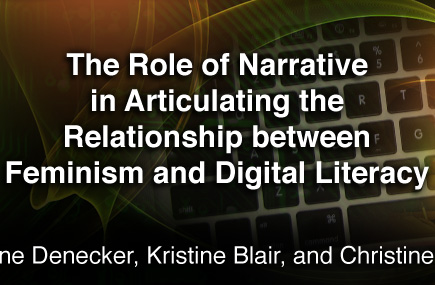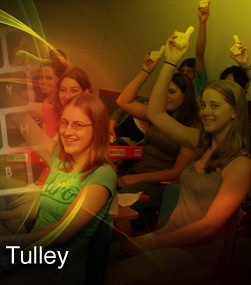Reflection
The role of narrative in how we articulate the relationship between feminism and digital literacy is at once simple and complex. Its simplicity derives from the sturdy threads that connect three major elements: narrative, feminism, and literacy. Working backward, “digital literacy” assumes an “expanded” definition of literacy beyond the alphabetic (Daley, 1999). And our attempt to expand the “discursive horizon” (Leclau & Monffe, 2001) suggests a feminist approach, because, for us, such explorations challenge the existing hegemony by providing an audience for marginalized voices. Narrative, then, connects the two. Because we argue that everyone has a story to tell, we also think that digital literacy narratives provide opportunities for hallmark feminist approaches: exploring the ways “our identities and subjectivities are multiple, changing, and always constructed in relation to others” (Maher, 1999, p. 50). These recursive processes are clearly evident in Gail’s and Kris’s narratives that begin this exhibit. More specifically, the narratives analyzed in each section of this exhibit demonstrate how DALN narratives might be approached for research and/or teaching and in turn serve as representative means for discovering as well as transforming notions of literacy. Our analysis of DALN narratives also suggests that female voices are sometimes privileged and sometimes subverted (and technology used to create the narrative often plays a role), the forces shaping the power dynamics of the narrators and their subjects are often complex, and, perhaps most importantly, our own roles as feminist researchers/educators affect how the narratives are positioned within the classrooms where we use them.
These changing “identities” and “subjectivities” are where the complexity comes in; because we utilize narrative as a vehicle for defining the relationship between feminism and digital literacy, we are challenged to examine our own subjectively constructed identities and multiple roles as scholars, advocates, colleagues, teachers, mentors, and students. We see, in the evolution of our own professional narratives, the ongoing fashioning of our identities as technofeminists. Calling upon feminist (re)positioning to analyze the cultural significance of the DALN and the individual narratives within the database also allows us to examine how narrative, feminism, and literacy are intertwined within our own research and teaching. Though narrative has historically held a special place within feminist scholarship (e.g. Women's Ways of Knowing), and oral narrative is prominent within African American scholarship, the current historical moment offers a space to examine the role technology might play in shaping our histories as teachers and researchers, as Gail and Kris suggest. Furthermore, through such reflexivity, we, and the students in our classes (and our students’ students), can begin to understand better how we shape and have been shaped by others as well as by various layers of privilege and disenfranchisement. To borrow the words of Rosanna Hertz (1997), “the self becomes both the subject of the study and the narrator” (p. xiii). We grow in cognizance, then, regarding the professional, social, political, cultural, and ideological ramifications of that “shaping,” while at the same time humbly acknowledging—as do the students in Chris’s African American literature class—that our narratives are just one part of a greater whole.
Although the examples we use in our respective sections of this exhibit may appear disparate, they simultaneously represent both a simple trajectory in documenting the past, present, and future of multimodal composing in our discipline and a complex reflexiveness as our larger field learns from the localized literacy practices of individual students, particularly within emerging multimodal spaces exemplified by DALN narratives that afford opportunities to portray identity through multiple means. Our experiences within this exhibit are shared stories of our literate lives as women and as educators who have had the opportunity to work together and learn from each other in professional, social, and academic contexts, negotiating our roles as mentors and colleagues among ourselves and with students. Specifically, through the process of researching DALN narratives as material artifacts, we recognize the potential of DALN narratives to offer a multilayered look at literacy—not only through the narrator’s description of his or her literacy practices, but also via the digital literacy practices used by the narrator to physically create the narrative or the DALN archivists to create the online repository.
This process of mentoring, researching, collaborating, and creating aligns with feminist theory, methodology, and pedagogy in its emphasis on collaborative, non-hierarchical, diverse spaces in which to experiment with the role technology plays in meaning-making and to, as Carole Stabile (1994) has argued, harness technology for our political goals. Students in Christine's class experience this meaning-making first-hand. Likewise, for our students and ourselves as feminist researchers, the process also allows a point of entry into larger cultural conversations about the relationship between identity, representation, and literacy and fosters a sense of feminist empowerment by allowing us to share our stories in ways that complicate, and in some cases refute, larger historical narratives about race, class, gender, and yes, technology. And in doing such work, we intuitively begin a process of defining and renegotiating not only what it means to do "feminist research" but also what it means to do "acceptable research" in areas ranging from literacy education and gender studies to narrative forms, technological pedagogies, and beyond.
Although examining the space(s) where narrative, feminism, and digital literacy dwell demands a measure of reflexivity, we recognize that space is not only about the relational shaping of identity. The empowerment of shaping and naming ourselves exists there as well. Sandra Gilbert and Susan Gubar (1979) write: “Women will starve in silence until new stories are created which confer to them the power of naming themselves” (qtd. in Heibrun, 1988, p. 34). Through digital literacy narratives and, in turn, transformative digital pedagogies, we can and do name ourselves, and in these spaces lies the power to reclaim the voices and identities of others as contributing to the dynamic history of computers and writing as a disciplinary community.
About Our Design Choices
In the Introduction of our exhibit, we argue that “literacy is always relational, the result of interactions among individuals, texts, and contexts.” “Relational,” too, best describes the Design Choices we have made in crafting this exhibit. While more organic than intentional, the relationship among the sections in the piece subtly reflects the framework of our own relationships as techno-feminist teacher scholars. Historically, the research of Blair foregrounds that of Tulley, and the research of Blair and Tulley (singularly and combined) foregrounds that of Denecker. Thus, when approached linearly, the organization of the exhibit demonstrates a sturdy thread of feminist scholarly activity and mentoring as it has evolved over time. However, beyond those “fore-groundings” lie a reciprocity born of respect for feminist approaches to teaching and learning. Aspects of that reciprocity appear in the piece via our internal references to each other’s scholarship. Simultaneously, though, much of that reciprocity dwells unseen in a web that holds up the exhibit. Planning meetings, emails, collaborative writing efforts, technical discussions, conference calls, and supportive advice all intertwine behind the scenes, not only as elements needed to build this particular exhibit, but also as threads in an ever-evolving field where the three authors strive to practice the feminist approaches that they preach.
An integral part of practicing feminist approaches includes fashioning spaces for a variety of voices to be heard, considered, and valued. As a result, we chose to incorporate video and audio narratives in their entireties to provide viewers the opportunity to authentically experience the nuances of gesture and voice inherent in the submissions of DALN contributors. We included specific excerpts of these same narratives, as well, to reinforce particular points and to better synthesize our subjects’ voices with our own. It should be noted that, as rhetoricians, we encourage our students to enter the “on-going conversation” on a subject; thus, interspersing our textual scholarship with the voices of DALN contributors challenged us to utilize “all available means” in reimagining how conversations might be created and read. Likewise, the hyperlinks we included allow viewers to more deeply mine the outside conversations rooting our exhibit or to “drop in” on specific internal lines of conversation that interest them most. Finally, the smiling young women who populate our banner represent our students—those who learn from and contribute to the feminist frameworks that ground our instruction. Their voices have impacted our own. And in ways both big and small, they reaffirm our shared belief in reciprocal feminist mentoring relationships as well as the power of transformative digital pedagogies.


